Audit and Ethics Report for Flight Centre Travel Group
VerifiedAdded on 2023/03/21
|12
|2463
|35
Report
AI Summary
This report presents an in-depth analysis of the audit and ethics aspects of Flight Centre Travel Group's 2018 annual report, focusing on materiality, analytical procedures, and the auditor's opinion. The report begins by defining materiality and its application in auditing, specifically within the context of Flight Centre. It then examines key items in the notes to the accounts, such as dividends, business combinations, and events after the balance sheet date, assessing their materiality. The analysis continues with the application of analytical procedures, including ratio analysis of capital structure, gearing, profitability, and shareholder ratios, to assess the company's financial performance. A detailed review of the cash flow statement is provided, highlighting key cash inflows and outflows, and discussing the implications for the going concern principle. Finally, the report reviews the auditor's report from Ernest and Young, including key audit matters. The report is a response to an assignment brief for CQUniversity Australia's ACCT20075 course.
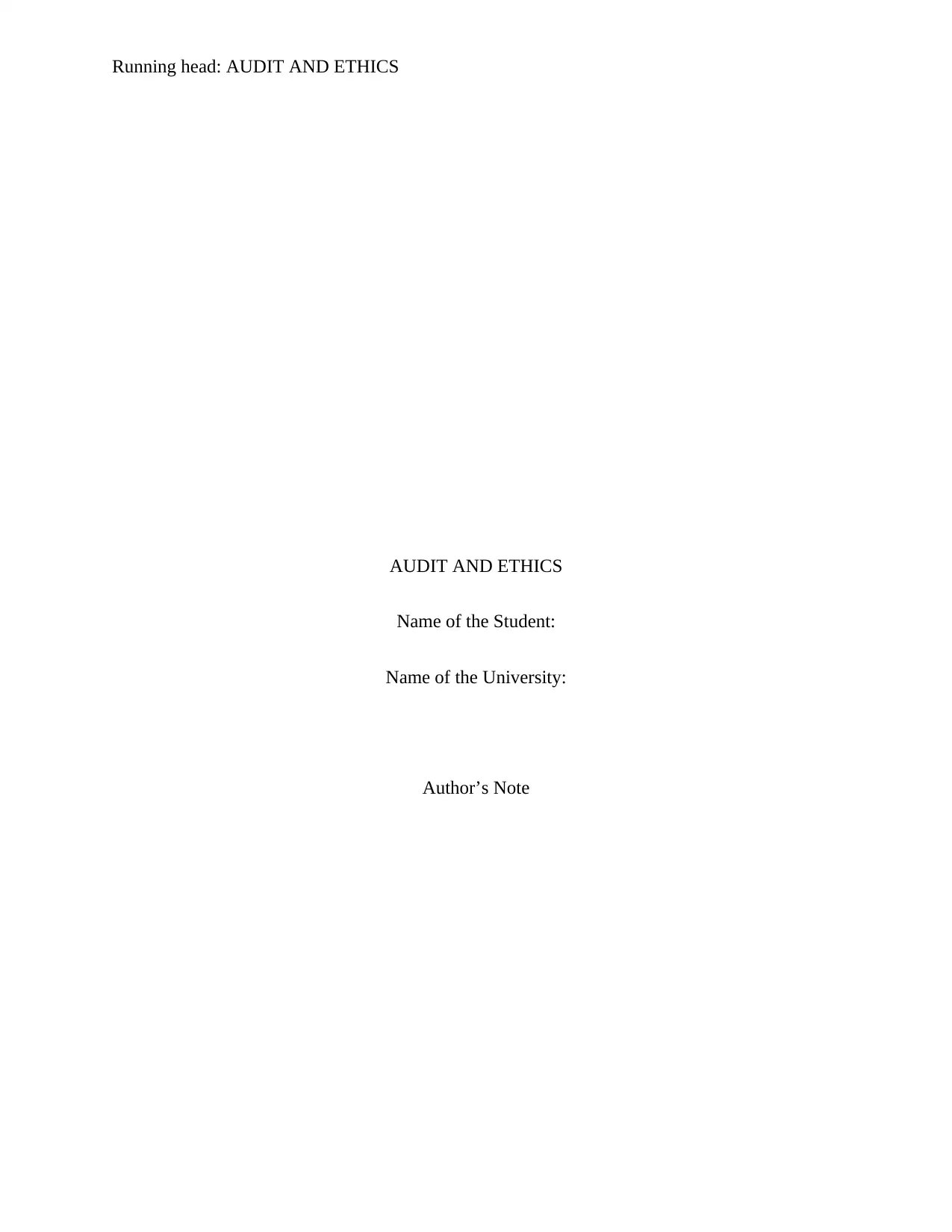
Running head: AUDIT AND ETHICS
AUDIT AND ETHICS
Name of the Student:
Name of the University:
Author’s Note
AUDIT AND ETHICS
Name of the Student:
Name of the University:
Author’s Note
Paraphrase This Document
Need a fresh take? Get an instant paraphrase of this document with our AI Paraphraser
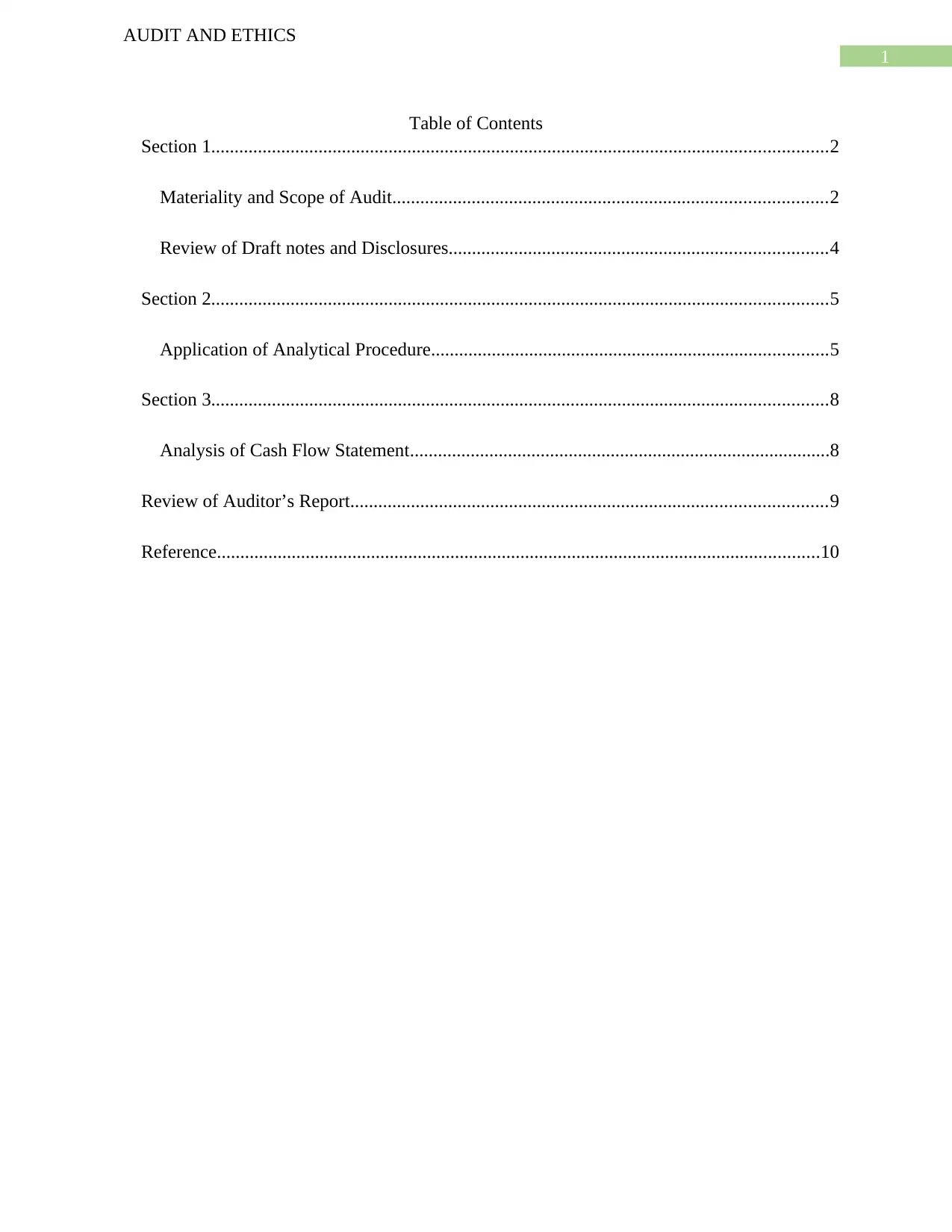
1
AUDIT AND ETHICS
Table of Contents
Section 1....................................................................................................................................2
Materiality and Scope of Audit.............................................................................................2
Review of Draft notes and Disclosures.................................................................................4
Section 2....................................................................................................................................5
Application of Analytical Procedure.....................................................................................5
Section 3....................................................................................................................................8
Analysis of Cash Flow Statement..........................................................................................8
Review of Auditor’s Report......................................................................................................9
Reference.................................................................................................................................10
AUDIT AND ETHICS
Table of Contents
Section 1....................................................................................................................................2
Materiality and Scope of Audit.............................................................................................2
Review of Draft notes and Disclosures.................................................................................4
Section 2....................................................................................................................................5
Application of Analytical Procedure.....................................................................................5
Section 3....................................................................................................................................8
Analysis of Cash Flow Statement..........................................................................................8
Review of Auditor’s Report......................................................................................................9
Reference.................................................................................................................................10
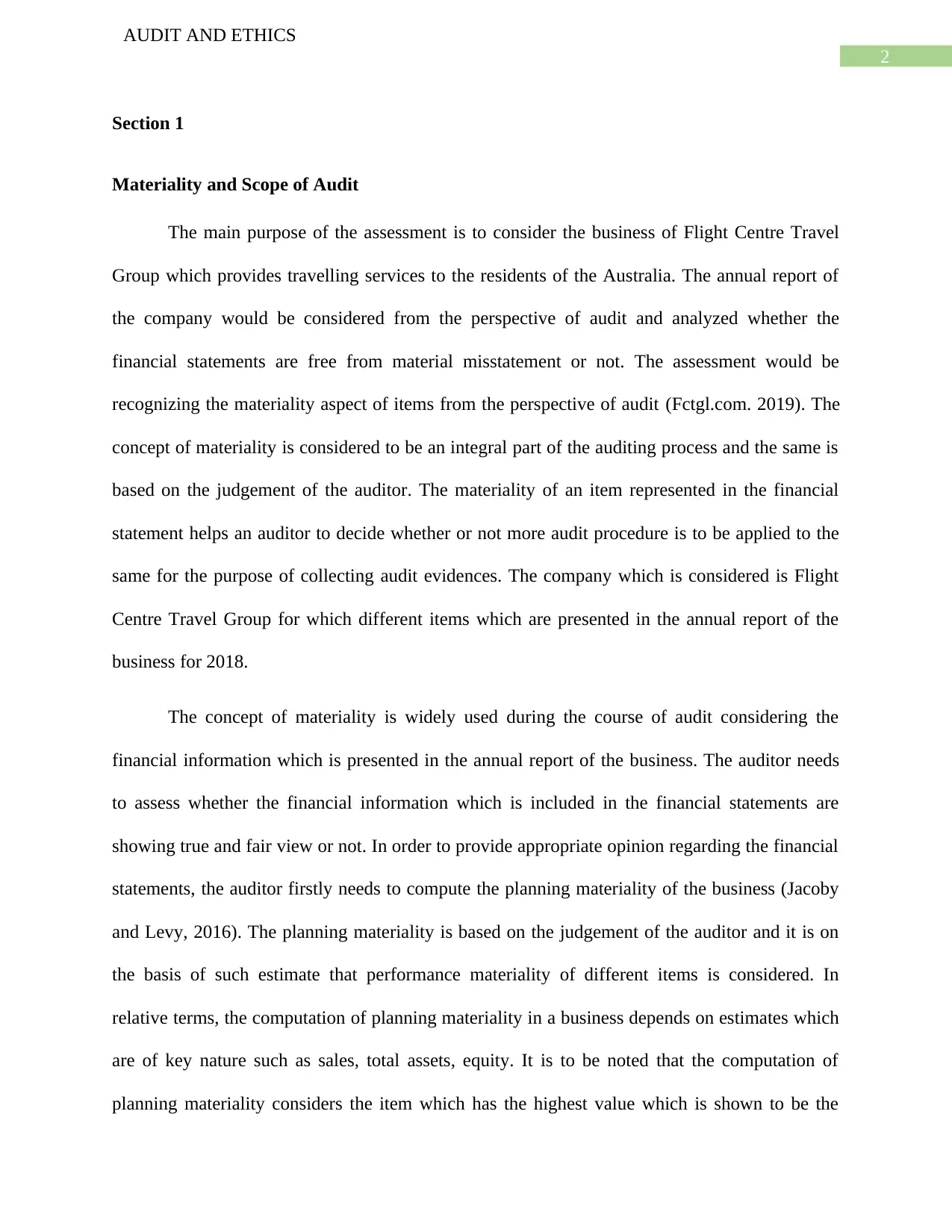
2
AUDIT AND ETHICS
Section 1
Materiality and Scope of Audit
The main purpose of the assessment is to consider the business of Flight Centre Travel
Group which provides travelling services to the residents of the Australia. The annual report of
the company would be considered from the perspective of audit and analyzed whether the
financial statements are free from material misstatement or not. The assessment would be
recognizing the materiality aspect of items from the perspective of audit (Fctgl.com. 2019). The
concept of materiality is considered to be an integral part of the auditing process and the same is
based on the judgement of the auditor. The materiality of an item represented in the financial
statement helps an auditor to decide whether or not more audit procedure is to be applied to the
same for the purpose of collecting audit evidences. The company which is considered is Flight
Centre Travel Group for which different items which are presented in the annual report of the
business for 2018.
The concept of materiality is widely used during the course of audit considering the
financial information which is presented in the annual report of the business. The auditor needs
to assess whether the financial information which is included in the financial statements are
showing true and fair view or not. In order to provide appropriate opinion regarding the financial
statements, the auditor firstly needs to compute the planning materiality of the business (Jacoby
and Levy, 2016). The planning materiality is based on the judgement of the auditor and it is on
the basis of such estimate that performance materiality of different items is considered. In
relative terms, the computation of planning materiality in a business depends on estimates which
are of key nature such as sales, total assets, equity. It is to be noted that the computation of
planning materiality considers the item which has the highest value which is shown to be the
AUDIT AND ETHICS
Section 1
Materiality and Scope of Audit
The main purpose of the assessment is to consider the business of Flight Centre Travel
Group which provides travelling services to the residents of the Australia. The annual report of
the company would be considered from the perspective of audit and analyzed whether the
financial statements are free from material misstatement or not. The assessment would be
recognizing the materiality aspect of items from the perspective of audit (Fctgl.com. 2019). The
concept of materiality is considered to be an integral part of the auditing process and the same is
based on the judgement of the auditor. The materiality of an item represented in the financial
statement helps an auditor to decide whether or not more audit procedure is to be applied to the
same for the purpose of collecting audit evidences. The company which is considered is Flight
Centre Travel Group for which different items which are presented in the annual report of the
business for 2018.
The concept of materiality is widely used during the course of audit considering the
financial information which is presented in the annual report of the business. The auditor needs
to assess whether the financial information which is included in the financial statements are
showing true and fair view or not. In order to provide appropriate opinion regarding the financial
statements, the auditor firstly needs to compute the planning materiality of the business (Jacoby
and Levy, 2016). The planning materiality is based on the judgement of the auditor and it is on
the basis of such estimate that performance materiality of different items is considered. In
relative terms, the computation of planning materiality in a business depends on estimates which
are of key nature such as sales, total assets, equity. It is to be noted that the computation of
planning materiality considers the item which has the highest value which is shown to be the
⊘ This is a preview!⊘
Do you want full access?
Subscribe today to unlock all pages.

Trusted by 1+ million students worldwide
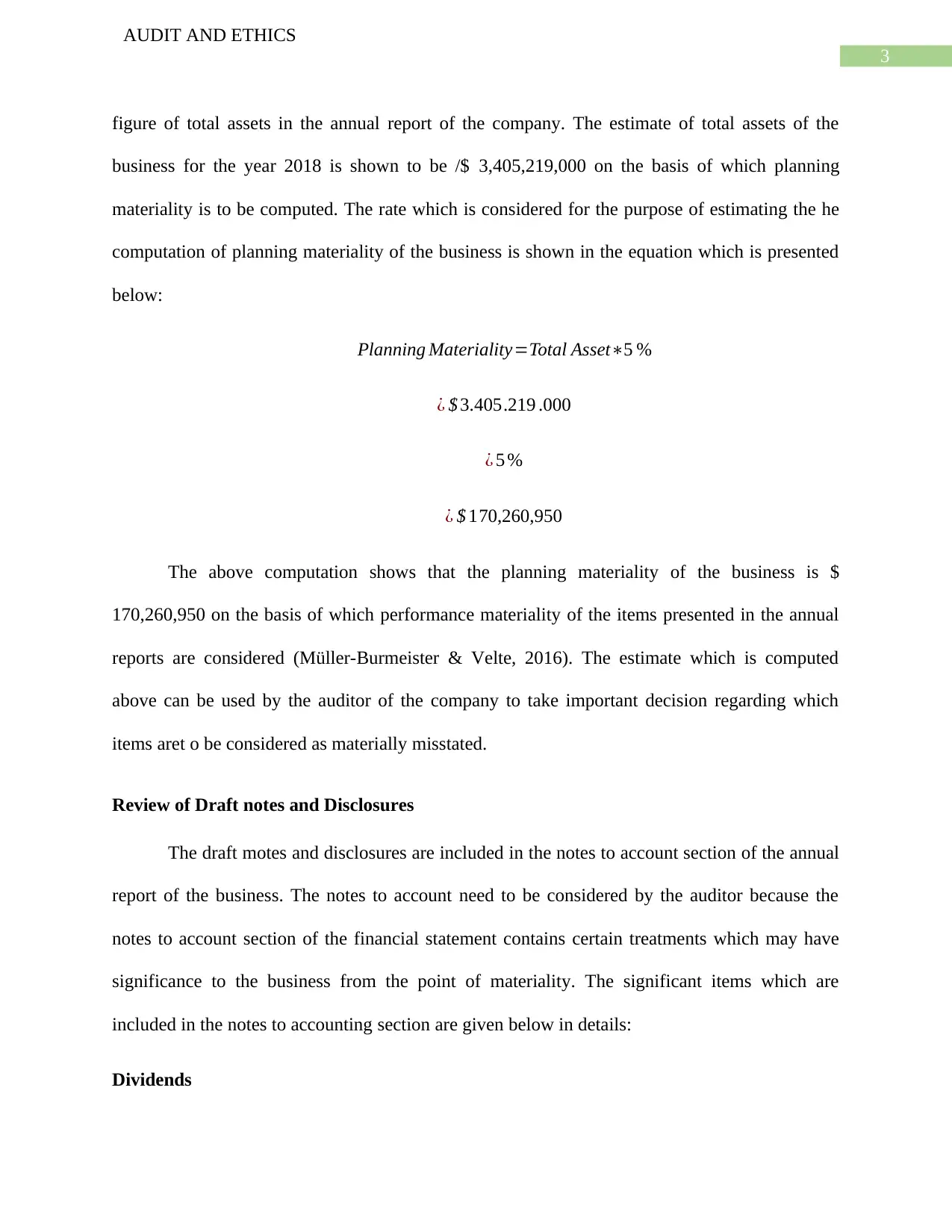
3
AUDIT AND ETHICS
figure of total assets in the annual report of the company. The estimate of total assets of the
business for the year 2018 is shown to be /$ 3,405,219,000 on the basis of which planning
materiality is to be computed. The rate which is considered for the purpose of estimating the he
computation of planning materiality of the business is shown in the equation which is presented
below:
Planning Materiality=Total Asset∗5 %
¿ $ 3.405.219 .000
¿ 5 %
¿ $ 170,260,950
The above computation shows that the planning materiality of the business is $
170,260,950 on the basis of which performance materiality of the items presented in the annual
reports are considered (Müller-Burmeister & Velte, 2016). The estimate which is computed
above can be used by the auditor of the company to take important decision regarding which
items aret o be considered as materially misstated.
Review of Draft notes and Disclosures
The draft motes and disclosures are included in the notes to account section of the annual
report of the business. The notes to account need to be considered by the auditor because the
notes to account section of the financial statement contains certain treatments which may have
significance to the business from the point of materiality. The significant items which are
included in the notes to accounting section are given below in details:
Dividends
AUDIT AND ETHICS
figure of total assets in the annual report of the company. The estimate of total assets of the
business for the year 2018 is shown to be /$ 3,405,219,000 on the basis of which planning
materiality is to be computed. The rate which is considered for the purpose of estimating the he
computation of planning materiality of the business is shown in the equation which is presented
below:
Planning Materiality=Total Asset∗5 %
¿ $ 3.405.219 .000
¿ 5 %
¿ $ 170,260,950
The above computation shows that the planning materiality of the business is $
170,260,950 on the basis of which performance materiality of the items presented in the annual
reports are considered (Müller-Burmeister & Velte, 2016). The estimate which is computed
above can be used by the auditor of the company to take important decision regarding which
items aret o be considered as materially misstated.
Review of Draft notes and Disclosures
The draft motes and disclosures are included in the notes to account section of the annual
report of the business. The notes to account need to be considered by the auditor because the
notes to account section of the financial statement contains certain treatments which may have
significance to the business from the point of materiality. The significant items which are
included in the notes to accounting section are given below in details:
Dividends
Paraphrase This Document
Need a fresh take? Get an instant paraphrase of this document with our AI Paraphraser
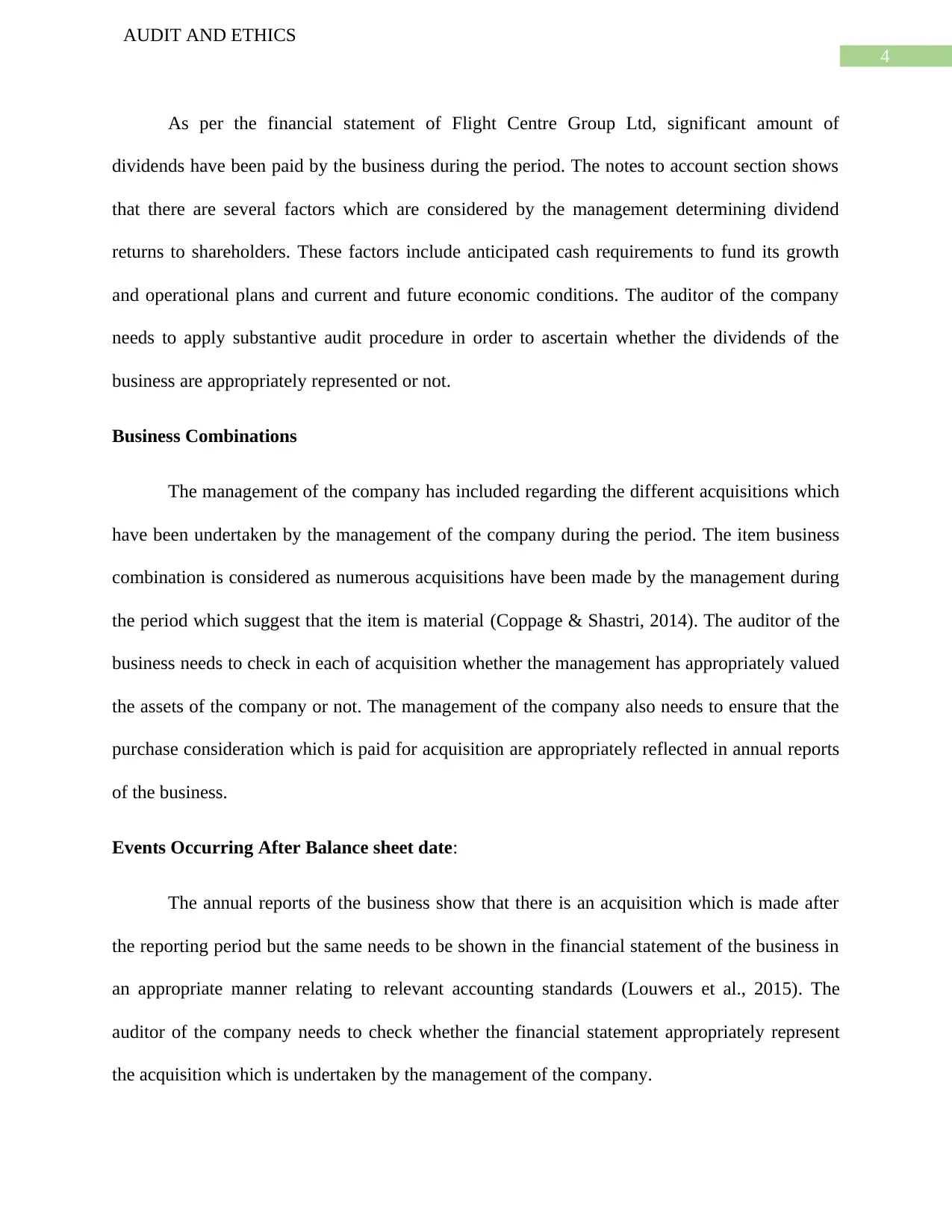
4
AUDIT AND ETHICS
As per the financial statement of Flight Centre Group Ltd, significant amount of
dividends have been paid by the business during the period. The notes to account section shows
that there are several factors which are considered by the management determining dividend
returns to shareholders. These factors include anticipated cash requirements to fund its growth
and operational plans and current and future economic conditions. The auditor of the company
needs to apply substantive audit procedure in order to ascertain whether the dividends of the
business are appropriately represented or not.
Business Combinations
The management of the company has included regarding the different acquisitions which
have been undertaken by the management of the company during the period. The item business
combination is considered as numerous acquisitions have been made by the management during
the period which suggest that the item is material (Coppage & Shastri, 2014). The auditor of the
business needs to check in each of acquisition whether the management has appropriately valued
the assets of the company or not. The management of the company also needs to ensure that the
purchase consideration which is paid for acquisition are appropriately reflected in annual reports
of the business.
Events Occurring After Balance sheet date:
The annual reports of the business show that there is an acquisition which is made after
the reporting period but the same needs to be shown in the financial statement of the business in
an appropriate manner relating to relevant accounting standards (Louwers et al., 2015). The
auditor of the company needs to check whether the financial statement appropriately represent
the acquisition which is undertaken by the management of the company.
AUDIT AND ETHICS
As per the financial statement of Flight Centre Group Ltd, significant amount of
dividends have been paid by the business during the period. The notes to account section shows
that there are several factors which are considered by the management determining dividend
returns to shareholders. These factors include anticipated cash requirements to fund its growth
and operational plans and current and future economic conditions. The auditor of the company
needs to apply substantive audit procedure in order to ascertain whether the dividends of the
business are appropriately represented or not.
Business Combinations
The management of the company has included regarding the different acquisitions which
have been undertaken by the management of the company during the period. The item business
combination is considered as numerous acquisitions have been made by the management during
the period which suggest that the item is material (Coppage & Shastri, 2014). The auditor of the
business needs to check in each of acquisition whether the management has appropriately valued
the assets of the company or not. The management of the company also needs to ensure that the
purchase consideration which is paid for acquisition are appropriately reflected in annual reports
of the business.
Events Occurring After Balance sheet date:
The annual reports of the business show that there is an acquisition which is made after
the reporting period but the same needs to be shown in the financial statement of the business in
an appropriate manner relating to relevant accounting standards (Louwers et al., 2015). The
auditor of the company needs to check whether the financial statement appropriately represent
the acquisition which is undertaken by the management of the company.
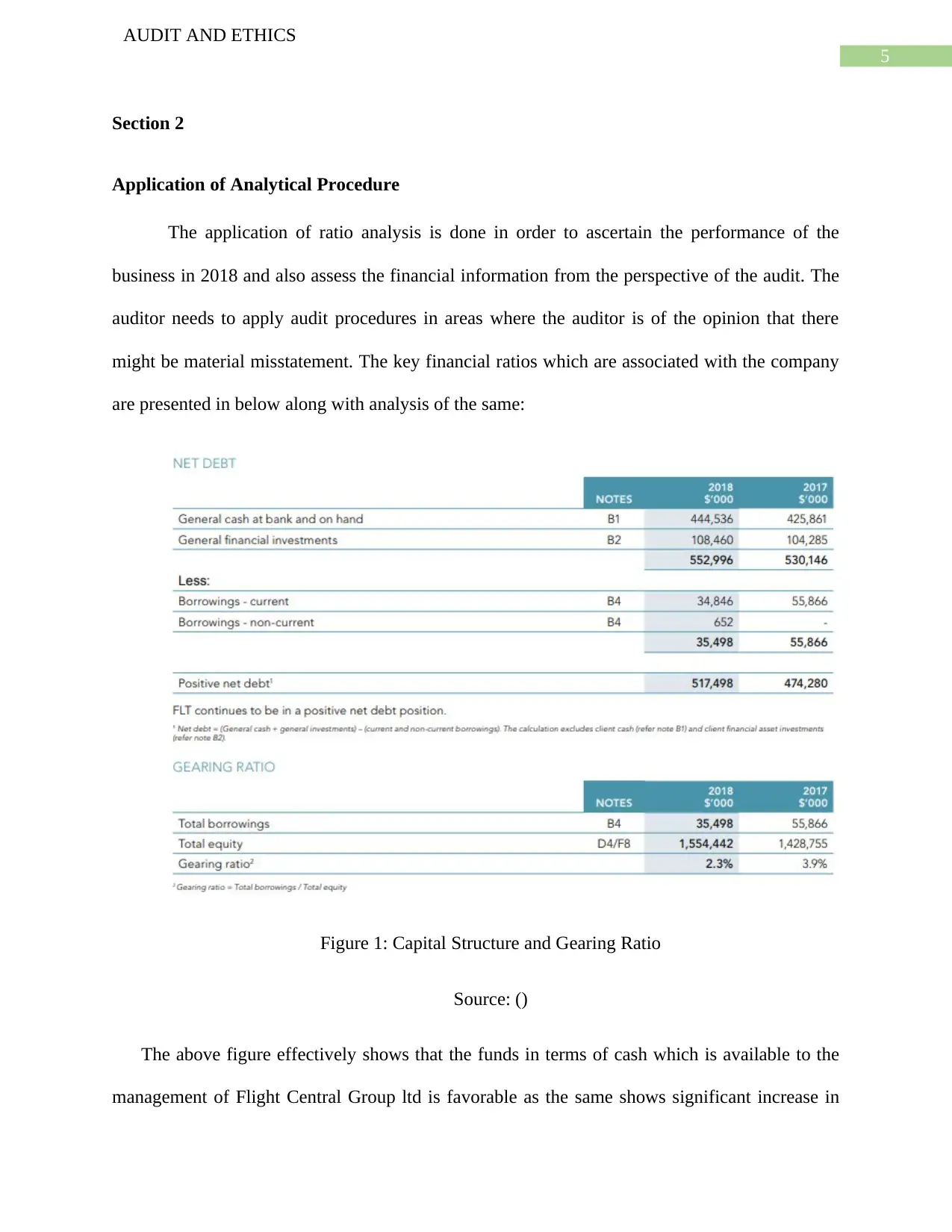
5
AUDIT AND ETHICS
Section 2
Application of Analytical Procedure
The application of ratio analysis is done in order to ascertain the performance of the
business in 2018 and also assess the financial information from the perspective of the audit. The
auditor needs to apply audit procedures in areas where the auditor is of the opinion that there
might be material misstatement. The key financial ratios which are associated with the company
are presented in below along with analysis of the same:
Figure 1: Capital Structure and Gearing Ratio
Source: ()
The above figure effectively shows that the funds in terms of cash which is available to the
management of Flight Central Group ltd is favorable as the same shows significant increase in
AUDIT AND ETHICS
Section 2
Application of Analytical Procedure
The application of ratio analysis is done in order to ascertain the performance of the
business in 2018 and also assess the financial information from the perspective of the audit. The
auditor needs to apply audit procedures in areas where the auditor is of the opinion that there
might be material misstatement. The key financial ratios which are associated with the company
are presented in below along with analysis of the same:
Figure 1: Capital Structure and Gearing Ratio
Source: ()
The above figure effectively shows that the funds in terms of cash which is available to the
management of Flight Central Group ltd is favorable as the same shows significant increase in
⊘ This is a preview!⊘
Do you want full access?
Subscribe today to unlock all pages.

Trusted by 1+ million students worldwide
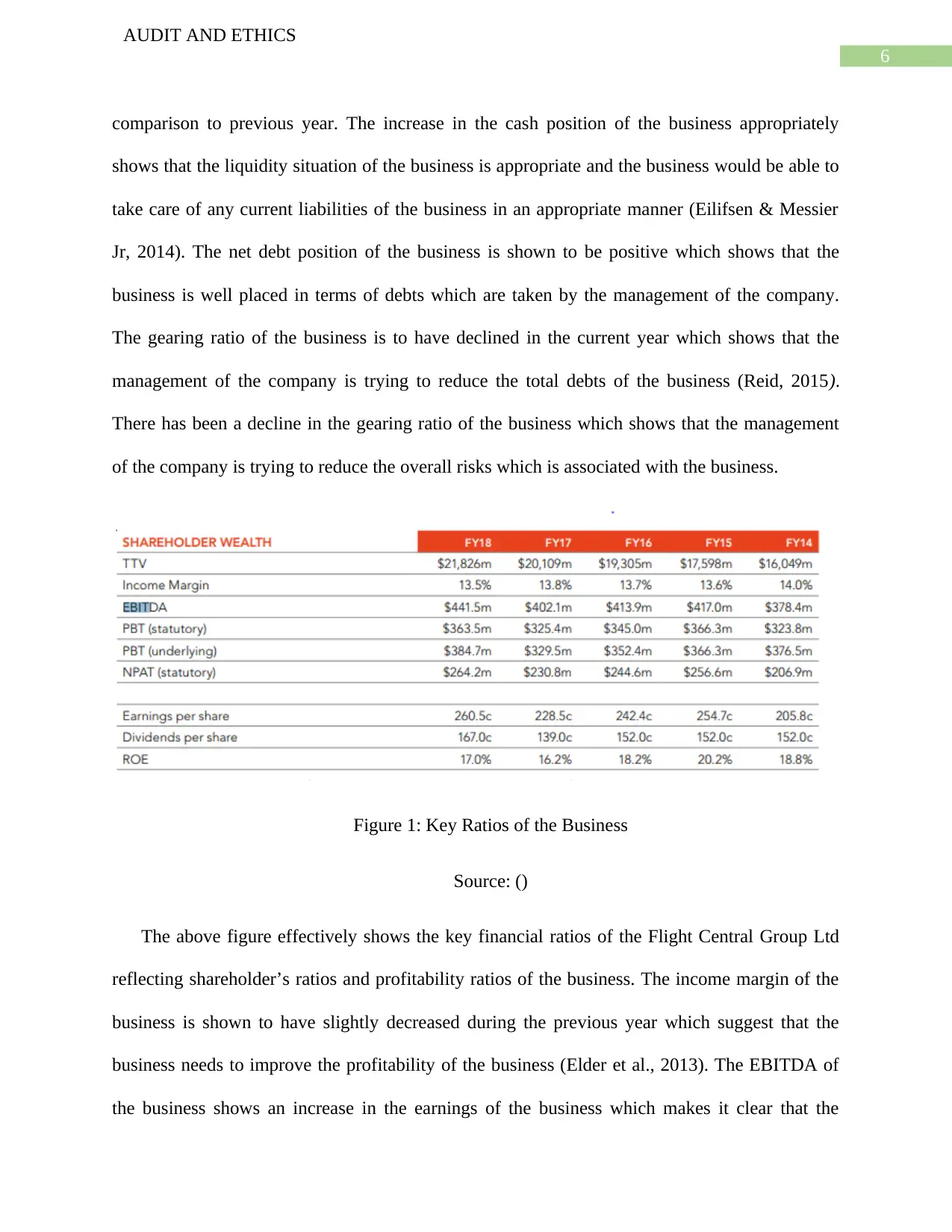
6
AUDIT AND ETHICS
comparison to previous year. The increase in the cash position of the business appropriately
shows that the liquidity situation of the business is appropriate and the business would be able to
take care of any current liabilities of the business in an appropriate manner (Eilifsen & Messier
Jr, 2014). The net debt position of the business is shown to be positive which shows that the
business is well placed in terms of debts which are taken by the management of the company.
The gearing ratio of the business is to have declined in the current year which shows that the
management of the company is trying to reduce the total debts of the business (Reid, 2015).
There has been a decline in the gearing ratio of the business which shows that the management
of the company is trying to reduce the overall risks which is associated with the business.
Figure 1: Key Ratios of the Business
Source: ()
The above figure effectively shows the key financial ratios of the Flight Central Group Ltd
reflecting shareholder’s ratios and profitability ratios of the business. The income margin of the
business is shown to have slightly decreased during the previous year which suggest that the
business needs to improve the profitability of the business (Elder et al., 2013). The EBITDA of
the business shows an increase in the earnings of the business which makes it clear that the
AUDIT AND ETHICS
comparison to previous year. The increase in the cash position of the business appropriately
shows that the liquidity situation of the business is appropriate and the business would be able to
take care of any current liabilities of the business in an appropriate manner (Eilifsen & Messier
Jr, 2014). The net debt position of the business is shown to be positive which shows that the
business is well placed in terms of debts which are taken by the management of the company.
The gearing ratio of the business is to have declined in the current year which shows that the
management of the company is trying to reduce the total debts of the business (Reid, 2015).
There has been a decline in the gearing ratio of the business which shows that the management
of the company is trying to reduce the overall risks which is associated with the business.
Figure 1: Key Ratios of the Business
Source: ()
The above figure effectively shows the key financial ratios of the Flight Central Group Ltd
reflecting shareholder’s ratios and profitability ratios of the business. The income margin of the
business is shown to have slightly decreased during the previous year which suggest that the
business needs to improve the profitability of the business (Elder et al., 2013). The EBITDA of
the business shows an increase in the earnings of the business which makes it clear that the
Paraphrase This Document
Need a fresh take? Get an instant paraphrase of this document with our AI Paraphraser
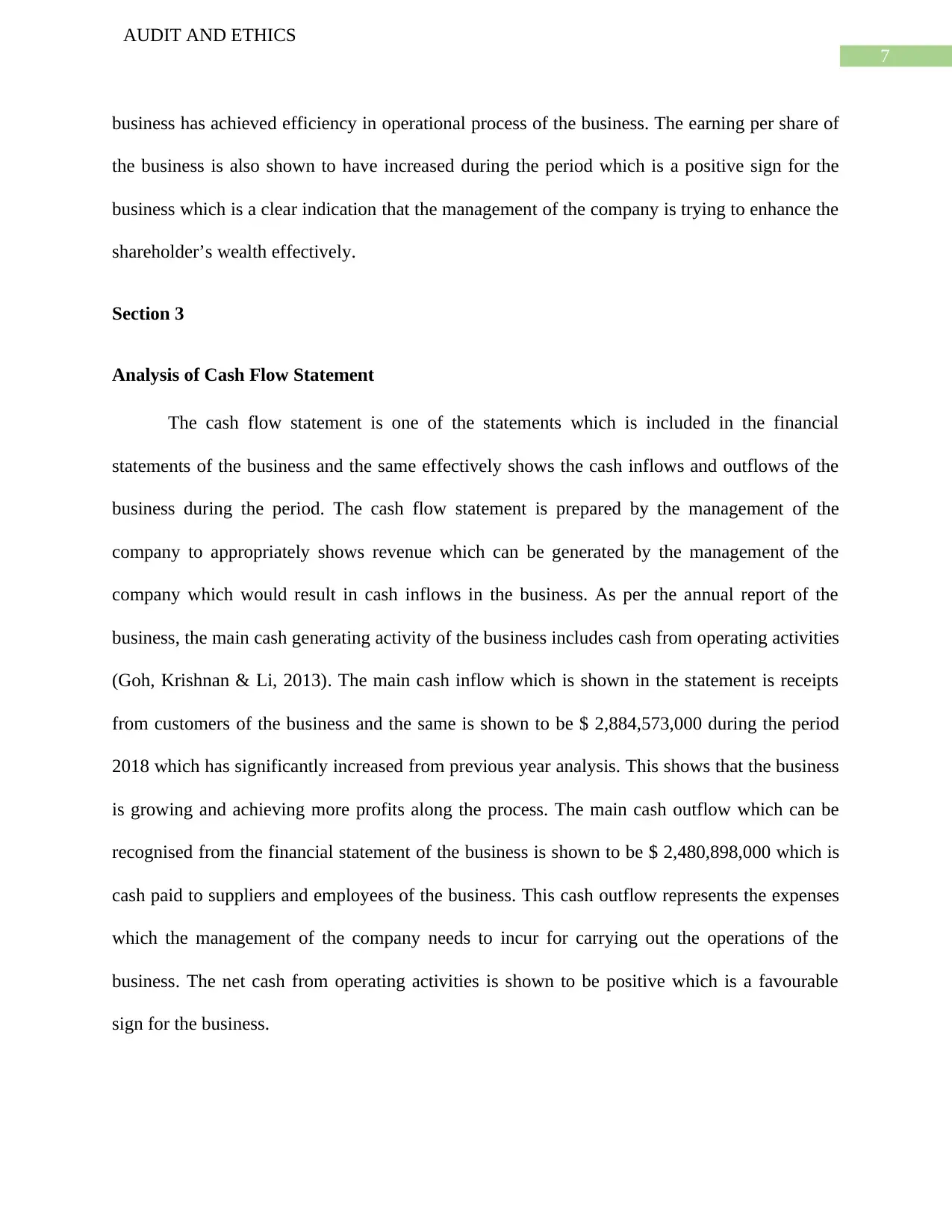
7
AUDIT AND ETHICS
business has achieved efficiency in operational process of the business. The earning per share of
the business is also shown to have increased during the period which is a positive sign for the
business which is a clear indication that the management of the company is trying to enhance the
shareholder’s wealth effectively.
Section 3
Analysis of Cash Flow Statement
The cash flow statement is one of the statements which is included in the financial
statements of the business and the same effectively shows the cash inflows and outflows of the
business during the period. The cash flow statement is prepared by the management of the
company to appropriately shows revenue which can be generated by the management of the
company which would result in cash inflows in the business. As per the annual report of the
business, the main cash generating activity of the business includes cash from operating activities
(Goh, Krishnan & Li, 2013). The main cash inflow which is shown in the statement is receipts
from customers of the business and the same is shown to be $ 2,884,573,000 during the period
2018 which has significantly increased from previous year analysis. This shows that the business
is growing and achieving more profits along the process. The main cash outflow which can be
recognised from the financial statement of the business is shown to be $ 2,480,898,000 which is
cash paid to suppliers and employees of the business. This cash outflow represents the expenses
which the management of the company needs to incur for carrying out the operations of the
business. The net cash from operating activities is shown to be positive which is a favourable
sign for the business.
AUDIT AND ETHICS
business has achieved efficiency in operational process of the business. The earning per share of
the business is also shown to have increased during the period which is a positive sign for the
business which is a clear indication that the management of the company is trying to enhance the
shareholder’s wealth effectively.
Section 3
Analysis of Cash Flow Statement
The cash flow statement is one of the statements which is included in the financial
statements of the business and the same effectively shows the cash inflows and outflows of the
business during the period. The cash flow statement is prepared by the management of the
company to appropriately shows revenue which can be generated by the management of the
company which would result in cash inflows in the business. As per the annual report of the
business, the main cash generating activity of the business includes cash from operating activities
(Goh, Krishnan & Li, 2013). The main cash inflow which is shown in the statement is receipts
from customers of the business and the same is shown to be $ 2,884,573,000 during the period
2018 which has significantly increased from previous year analysis. This shows that the business
is growing and achieving more profits along the process. The main cash outflow which can be
recognised from the financial statement of the business is shown to be $ 2,480,898,000 which is
cash paid to suppliers and employees of the business. This cash outflow represents the expenses
which the management of the company needs to incur for carrying out the operations of the
business. The net cash from operating activities is shown to be positive which is a favourable
sign for the business.
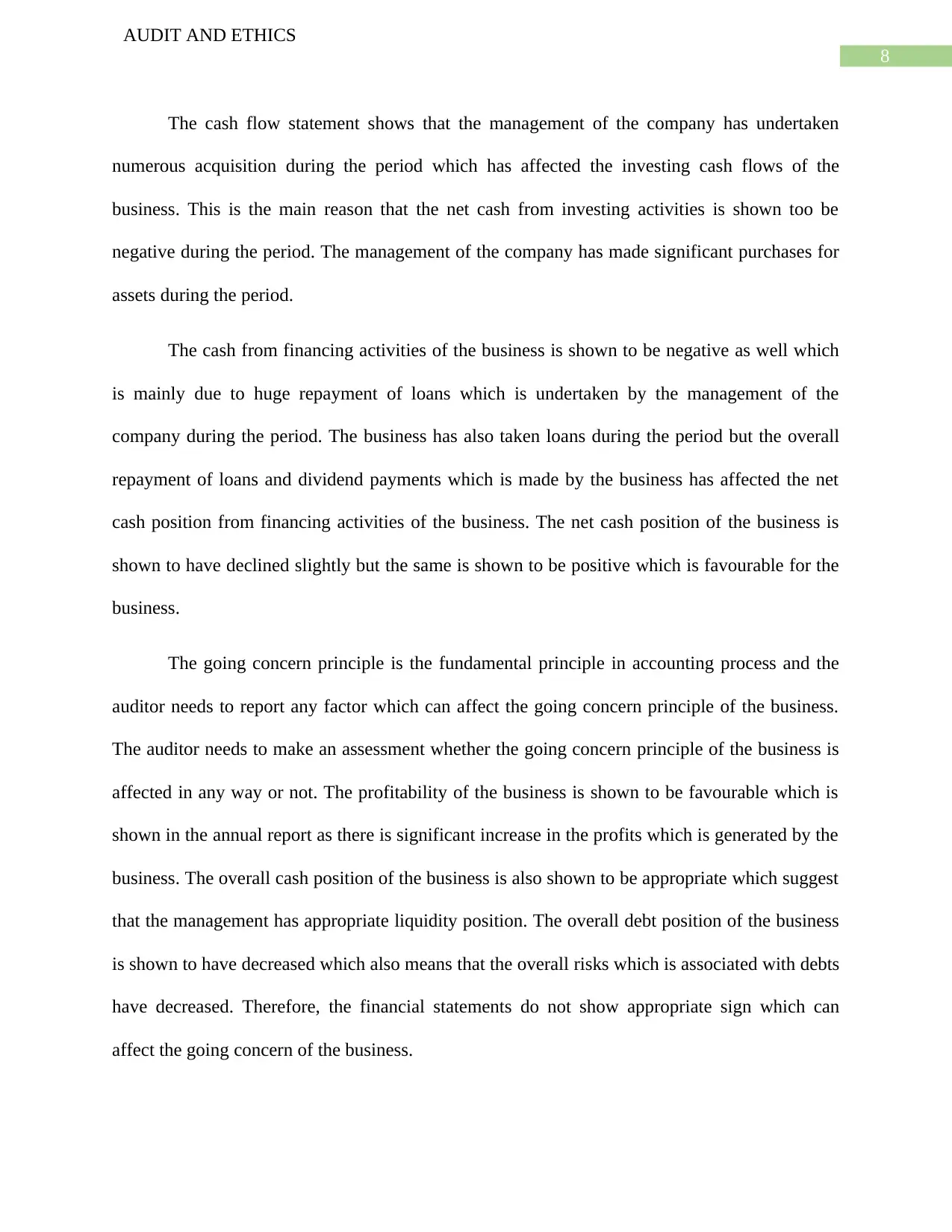
8
AUDIT AND ETHICS
The cash flow statement shows that the management of the company has undertaken
numerous acquisition during the period which has affected the investing cash flows of the
business. This is the main reason that the net cash from investing activities is shown too be
negative during the period. The management of the company has made significant purchases for
assets during the period.
The cash from financing activities of the business is shown to be negative as well which
is mainly due to huge repayment of loans which is undertaken by the management of the
company during the period. The business has also taken loans during the period but the overall
repayment of loans and dividend payments which is made by the business has affected the net
cash position from financing activities of the business. The net cash position of the business is
shown to have declined slightly but the same is shown to be positive which is favourable for the
business.
The going concern principle is the fundamental principle in accounting process and the
auditor needs to report any factor which can affect the going concern principle of the business.
The auditor needs to make an assessment whether the going concern principle of the business is
affected in any way or not. The profitability of the business is shown to be favourable which is
shown in the annual report as there is significant increase in the profits which is generated by the
business. The overall cash position of the business is also shown to be appropriate which suggest
that the management has appropriate liquidity position. The overall debt position of the business
is shown to have decreased which also means that the overall risks which is associated with debts
have decreased. Therefore, the financial statements do not show appropriate sign which can
affect the going concern of the business.
AUDIT AND ETHICS
The cash flow statement shows that the management of the company has undertaken
numerous acquisition during the period which has affected the investing cash flows of the
business. This is the main reason that the net cash from investing activities is shown too be
negative during the period. The management of the company has made significant purchases for
assets during the period.
The cash from financing activities of the business is shown to be negative as well which
is mainly due to huge repayment of loans which is undertaken by the management of the
company during the period. The business has also taken loans during the period but the overall
repayment of loans and dividend payments which is made by the business has affected the net
cash position from financing activities of the business. The net cash position of the business is
shown to have declined slightly but the same is shown to be positive which is favourable for the
business.
The going concern principle is the fundamental principle in accounting process and the
auditor needs to report any factor which can affect the going concern principle of the business.
The auditor needs to make an assessment whether the going concern principle of the business is
affected in any way or not. The profitability of the business is shown to be favourable which is
shown in the annual report as there is significant increase in the profits which is generated by the
business. The overall cash position of the business is also shown to be appropriate which suggest
that the management has appropriate liquidity position. The overall debt position of the business
is shown to have decreased which also means that the overall risks which is associated with debts
have decreased. Therefore, the financial statements do not show appropriate sign which can
affect the going concern of the business.
⊘ This is a preview!⊘
Do you want full access?
Subscribe today to unlock all pages.

Trusted by 1+ million students worldwide
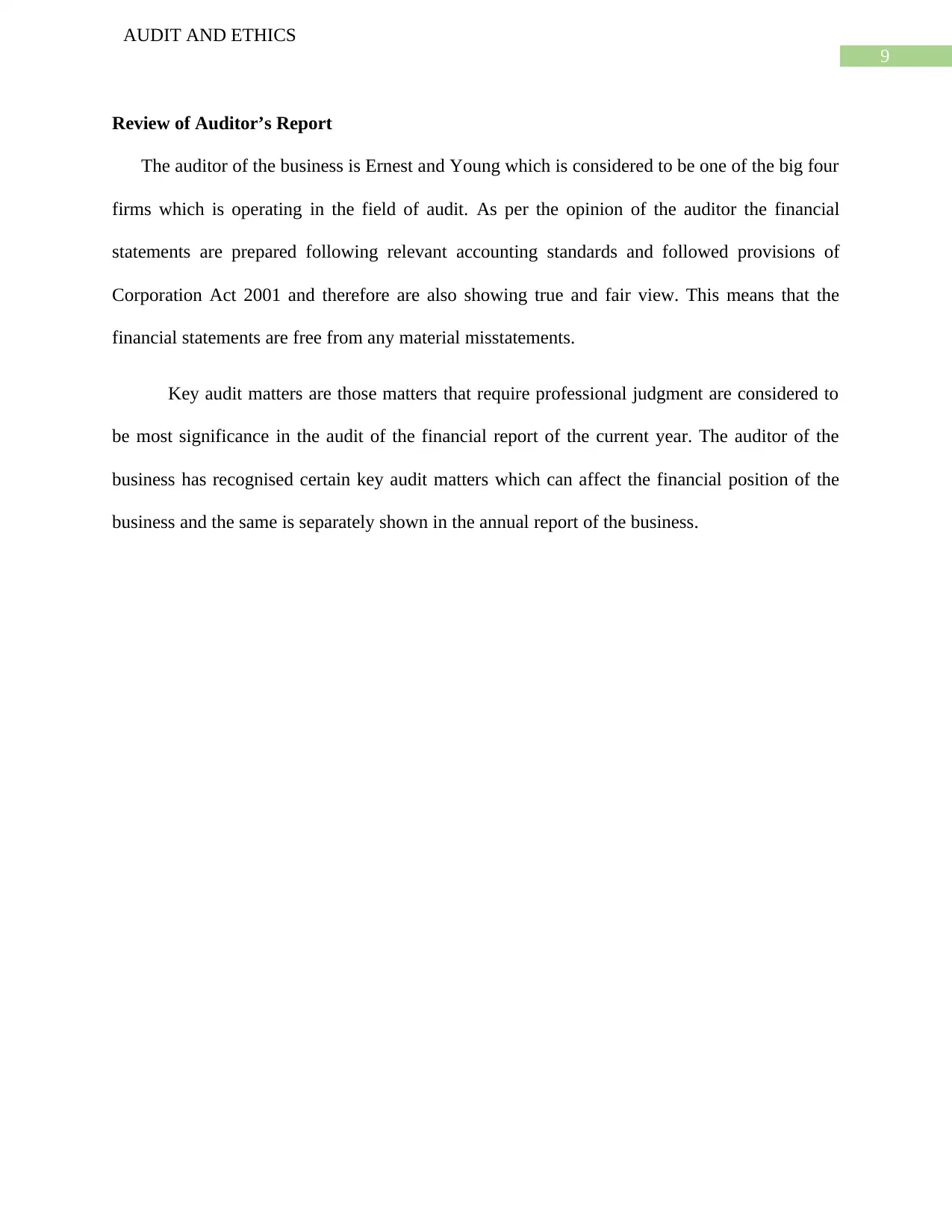
9
AUDIT AND ETHICS
Review of Auditor’s Report
The auditor of the business is Ernest and Young which is considered to be one of the big four
firms which is operating in the field of audit. As per the opinion of the auditor the financial
statements are prepared following relevant accounting standards and followed provisions of
Corporation Act 2001 and therefore are also showing true and fair view. This means that the
financial statements are free from any material misstatements.
Key audit matters are those matters that require professional judgment are considered to
be most significance in the audit of the financial report of the current year. The auditor of the
business has recognised certain key audit matters which can affect the financial position of the
business and the same is separately shown in the annual report of the business.
AUDIT AND ETHICS
Review of Auditor’s Report
The auditor of the business is Ernest and Young which is considered to be one of the big four
firms which is operating in the field of audit. As per the opinion of the auditor the financial
statements are prepared following relevant accounting standards and followed provisions of
Corporation Act 2001 and therefore are also showing true and fair view. This means that the
financial statements are free from any material misstatements.
Key audit matters are those matters that require professional judgment are considered to
be most significance in the audit of the financial report of the current year. The auditor of the
business has recognised certain key audit matters which can affect the financial position of the
business and the same is separately shown in the annual report of the business.
Paraphrase This Document
Need a fresh take? Get an instant paraphrase of this document with our AI Paraphraser
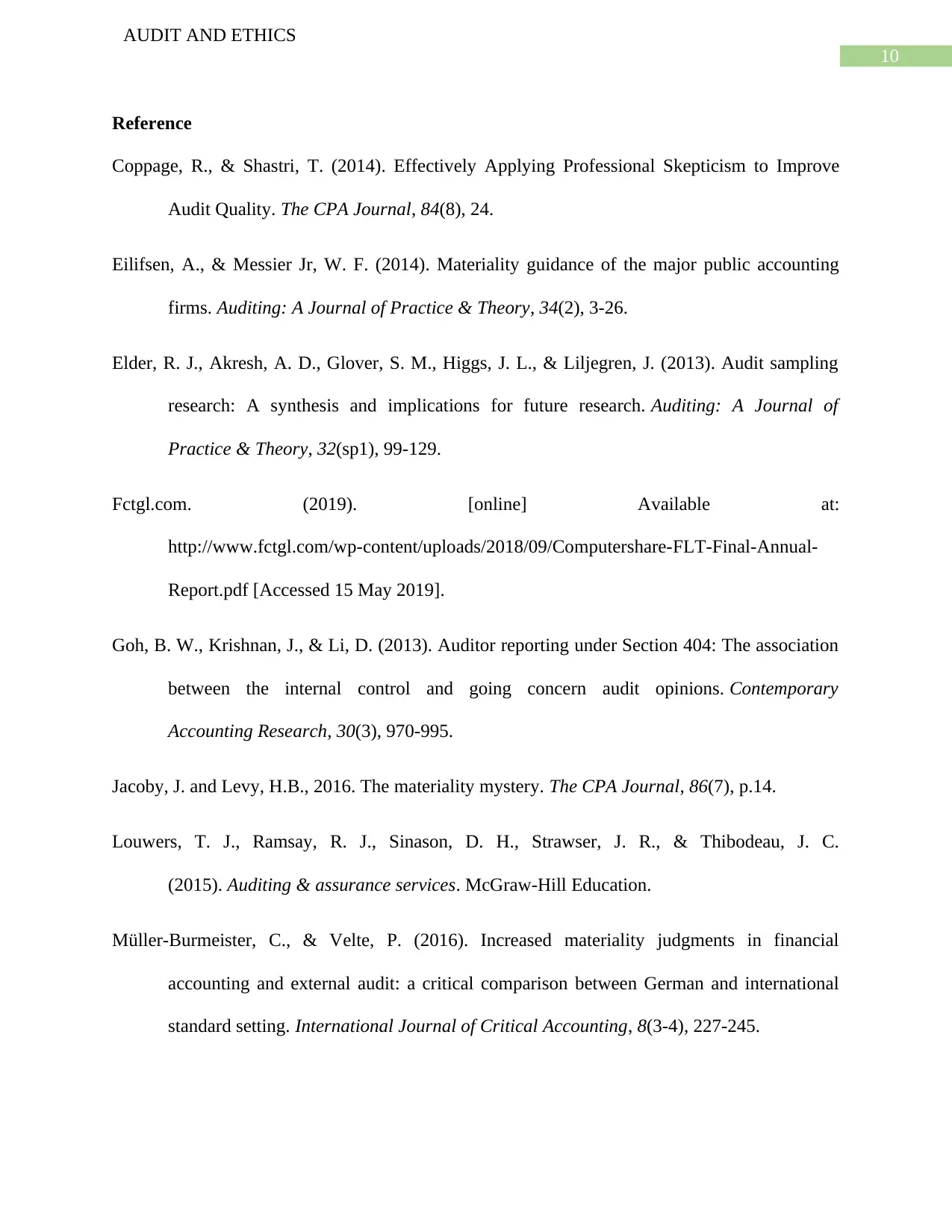
10
AUDIT AND ETHICS
Reference
Coppage, R., & Shastri, T. (2014). Effectively Applying Professional Skepticism to Improve
Audit Quality. The CPA Journal, 84(8), 24.
Eilifsen, A., & Messier Jr, W. F. (2014). Materiality guidance of the major public accounting
firms. Auditing: A Journal of Practice & Theory, 34(2), 3-26.
Elder, R. J., Akresh, A. D., Glover, S. M., Higgs, J. L., & Liljegren, J. (2013). Audit sampling
research: A synthesis and implications for future research. Auditing: A Journal of
Practice & Theory, 32(sp1), 99-129.
Fctgl.com. (2019). [online] Available at:
http://www.fctgl.com/wp-content/uploads/2018/09/Computershare-FLT-Final-Annual-
Report.pdf [Accessed 15 May 2019].
Goh, B. W., Krishnan, J., & Li, D. (2013). Auditor reporting under Section 404: The association
between the internal control and going concern audit opinions. Contemporary
Accounting Research, 30(3), 970-995.
Jacoby, J. and Levy, H.B., 2016. The materiality mystery. The CPA Journal, 86(7), p.14.
Louwers, T. J., Ramsay, R. J., Sinason, D. H., Strawser, J. R., & Thibodeau, J. C.
(2015). Auditing & assurance services. McGraw-Hill Education.
Müller-Burmeister, C., & Velte, P. (2016). Increased materiality judgments in financial
accounting and external audit: a critical comparison between German and international
standard setting. International Journal of Critical Accounting, 8(3-4), 227-245.
AUDIT AND ETHICS
Reference
Coppage, R., & Shastri, T. (2014). Effectively Applying Professional Skepticism to Improve
Audit Quality. The CPA Journal, 84(8), 24.
Eilifsen, A., & Messier Jr, W. F. (2014). Materiality guidance of the major public accounting
firms. Auditing: A Journal of Practice & Theory, 34(2), 3-26.
Elder, R. J., Akresh, A. D., Glover, S. M., Higgs, J. L., & Liljegren, J. (2013). Audit sampling
research: A synthesis and implications for future research. Auditing: A Journal of
Practice & Theory, 32(sp1), 99-129.
Fctgl.com. (2019). [online] Available at:
http://www.fctgl.com/wp-content/uploads/2018/09/Computershare-FLT-Final-Annual-
Report.pdf [Accessed 15 May 2019].
Goh, B. W., Krishnan, J., & Li, D. (2013). Auditor reporting under Section 404: The association
between the internal control and going concern audit opinions. Contemporary
Accounting Research, 30(3), 970-995.
Jacoby, J. and Levy, H.B., 2016. The materiality mystery. The CPA Journal, 86(7), p.14.
Louwers, T. J., Ramsay, R. J., Sinason, D. H., Strawser, J. R., & Thibodeau, J. C.
(2015). Auditing & assurance services. McGraw-Hill Education.
Müller-Burmeister, C., & Velte, P. (2016). Increased materiality judgments in financial
accounting and external audit: a critical comparison between German and international
standard setting. International Journal of Critical Accounting, 8(3-4), 227-245.
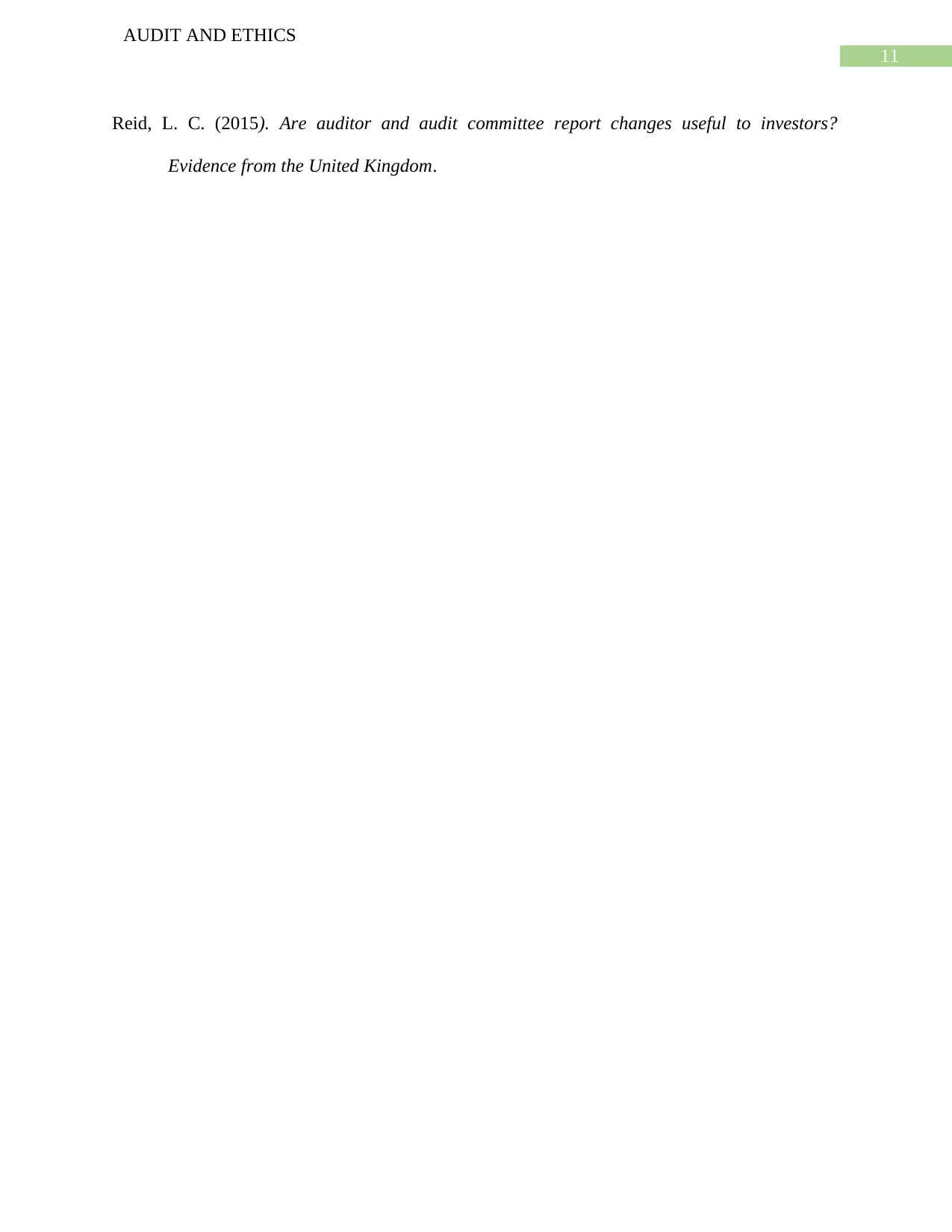
11
AUDIT AND ETHICS
Reid, L. C. (2015). Are auditor and audit committee report changes useful to investors?
Evidence from the United Kingdom.
AUDIT AND ETHICS
Reid, L. C. (2015). Are auditor and audit committee report changes useful to investors?
Evidence from the United Kingdom.
⊘ This is a preview!⊘
Do you want full access?
Subscribe today to unlock all pages.

Trusted by 1+ million students worldwide
1 out of 12
Related Documents
Your All-in-One AI-Powered Toolkit for Academic Success.
+13062052269
info@desklib.com
Available 24*7 on WhatsApp / Email
![[object Object]](/_next/static/media/star-bottom.7253800d.svg)
Unlock your academic potential
Copyright © 2020–2025 A2Z Services. All Rights Reserved. Developed and managed by ZUCOL.





